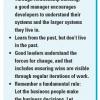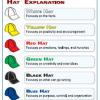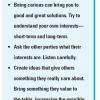 |
Go, Team! Fed up with good-ol'-boy salesmen, a manufacturing mindset, and just-get-it-out-the-door directions? A little assertiveness, a few ounces of patience, a dash of charm, a lot of leadership, and some attitude adjustment by everyone might help. Read how one manager made the world a better place to work one small victory at a time.
|
|
|
|
Are Your Pants on Fire, or Do You Suffer from Split Focus? Some schedule games—Split Focus and Pants on Fire—are the result of your management not making certain decisions about the project portfolio. Without those decisions, your project has problems. In this column, Johanna Rothman explains what you can do when the problems on your project are caused by your management’s lack of decision making.
|
|
 |
Questions You Should Ask It's a technique children and teenagers have mastered: asking "why" until they get to an acceptable response (or until we're too tired to continue answering). Find out how Michele Sliger uses a similar approach designed by Six Sigma to drill down into the underlying cause of any problem within software projects. She then continues the inquisition with a series of other questions in order to find out how these problems affect business value and technology. Read on to learn what these questions are and how you can start using them to find out why things aren't going as planned.
|
|
|
|
The Abolition of Ignorance The testing profession isn't easily mastered, and isn't something that can be perfected by practice alone. Good testers study testing to improve their knowledge of the areas they know about, but great testers strive to find out about areas of software testing they don't yet realize they don't know about.
|
|
 |
Six Thinking Hats for Testers Fresh ideas can provoke us into discovering great insights: Six thinking hats did just that for Julian Harty, who then applied them to software testing with great success. He, and tens of others, has found the thinking hats easy to use, practical, and very productive. Read on to find out how you can apply them to your work.
|
|
|
|
What's a Manager to Do? Self-organizing teams still need managers. But those managers need to rethink how they do their jobs and consider how much self-management the team can take on. Finding the sweet spot between hands on and hands off is the key.
|
|
 |
Don't Fear the Repartee Conflict reduces people's productivity and generosity toward the organization and their coworkers. These four steps can help defuse a conflict situation and improve the chances for a solution that at the least, both parties can live with.
|
|
|
|
Metrics that Motivate To implement a meaningful incentive system for your team, you need to select metrics that encourage the behaviors you need and the results you want. But first you have to decide what you need and want.
|
|
 |
Simple Summaries Of Complex Projects How can we meaningfully summarize—in a brief status report without losing important details—the successes and setbacks our projects experience?
|
|
|
|
The Tester Who Came In from the Cold Traditionally, relationships between testing and coding teams often bordered on frosty. But the wall has started to come down, especially in organizations that have embraced agile principles, values, and practices.
|
|

